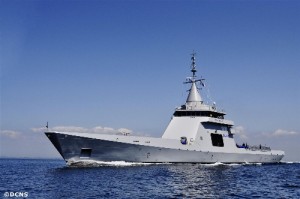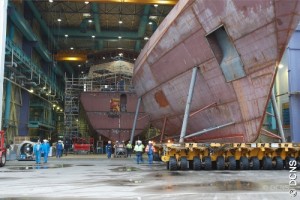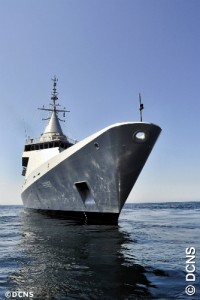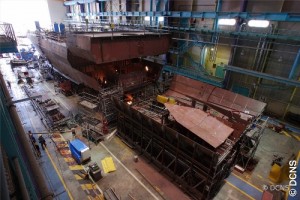As new threats emerge, military patrol vessels have to deliver outstanding performance offshore. Elisabeth Fischer speaks to Christophe Bouvier, DCNS surface ship architect, about the latest addition to the Gowind family of defence and patrol vessels.
A changing naval defence sector demands new technology, as modern navies are increasingly required to go beyond their traditional function of guarding borders and sea boundaries to deal with growing problems of drug trafficking, sea piracy, terrorism, fisheries policing, environmental protection, salvage operations and humanitarian aid.
To cope with the increasing surveillance and security demands, many countries are investing in highly technological patrol vessels.
![]()

A changing naval defence sector demands new technology, as modern navies are increasingly required to go beyond their traditional function of guarding borders and sea boundaries.
Fast and reliable, equipped with the newest radar surveillance technologies, search and track and submarine detection, offshore patrol vessels (OPVs) have to apply ever more sophisticated equipment to keep the world’s oceans safe. French defence company DCNS has recently launched its first highly technological Gowind Class OPV L’Adroit, which is currently undergoing sea trials and will be tested by the French Navy in the coming three years.
Here, DCNS surface ship architect Christophe Bouvier talks about the technology and experience needed to build an efficient OPV in today’s changing maritime environment, profiling the latest equipment in the fight against crime on the high seas.
Elisabeth Fischer: How have OPV surveillance and combat demands changed in recent years?
Christophe Bouvier: From the littorals to the high seas, the spectrum of missions assigned to navies increasingly includes maritime traffic control, maritime safety and security (MSS), protection of fisheries, marine environments and offshore resources, humanitarian assistance, interdiction of piracy, illegal immigration and drug trafficking, and of course counter-terrorism.
There is a developing need for multimission capable ships to fight asymmetric threats. This can be addressed by interacting with multiple actors such as with other ships, navies, international coalitions, coast guards or civilian vessels, and by the ability to quickly launch missions with the assistance of drones, helicopters and RHIB.
EF: How does the design of the OPV Gowind meet these demands?
CB: The Gowind family benefits from operational feedbacks and lessons learned by the French Navy and various special forces from all over the world. The aim is to combine flexible payload and optimised operational availability.
The OPV Gowind is the entry-level representative of the Gowind family, meeting the operational needs of a large number of navies focusing on coastal missions and homeland security.
The design, construction and trials have been performed by a dedicated team, all volunteers, to develop and apply new methods and solutions not previously introduced at Lorient shipyard, which up to now had specialised in the construction of much bigger surface combatants.
The first step was to set up a multidisciplinary multiskills team and give it freedom across the programme. The aim is to enable this new structure to build the ship in record time, less than 20 months from the first cut to delivery to the customer in the autumn of 2011.
The ship and its mission system have been designed as a whole: a panoramic bridge offers 360° vision, almost down to the waterline to improved fight against asymmetric threats and to offer a visual monitoring of helicopter, UAV, USV and RHIBs operations. A single mast concept reduces EMI issues and offers 360° coverage for all the sensors, as well as a sea-proven stern-mounted quick launch-and-recovery system for two commando boats, usable also at high seas with the ship underway.
The design also offers accommodation for UAVs for remote reconnaissance and an organic helicopter, depending on the size of the vessel. With a length overall of 87m, the Adroit offers three weeks blue-water endurance, a range of 8,000nm and a top speed of 21kn.

To cope with the increasing surveillance and security demands, many countries are investing in highly technological patrol vessels.
EF: What are the surveillance and combat systems onboard of OPV’s to successfully withstand naval threats?
CB: The objective for a performing OPV is mostly to gather information to interact efficiently with multiple actors, such as other ships, navies, international coalitions, coast guards and civilian vessels, and swiftly launch missions.
The combat systems is often simple compared to a corvette or a frigate but the Gowind family benefits from DCNS’s vast experience in IT and command information systems.
The ship mission system is based on the POLARIS system, a sea-proven compact solution designed to fulfil navies and coast guards’ needs for surveillance, littoral zone protection and economical exclusive zone protection missions.
The system offers scalable functionalities that are built for maritime situation awareness, interoperability and surface warfare management.
The functional core is a robust, optimised and capable tactical system, which takes benefit of DCNS combat systems already in service. It features the capability to interface a great number of surveillance and identification sensors such as radar, AIS and ADS-B, video and infra-red cameras, radar and communication ESM equipments. The improved anti-surface warfare version provides the capacity to operate guns and surface-to-surface missile systems.
In conjunction with shore-based control centres and other networked ships, the automatic detection of suspicious behaviour by ships and other craft is also possible.
EF: At the end of July, the OPV Gowind started undergoing sea trials. What are the first results?
CB: The start of these first sea trials is a symbolic milestone that testifies to the remarkable teamwork between DCNS, the project’s investors and co-contractors, and the trial crews. Everybody has brought their knowledge and expertise to the table, and their unflagging commitment has made it possible to consistently meet the programme’s ambitious industrial milestones.
During the sea trials, more than 50 technicians on board the vessel conducted testing of the ship’s fire-fighting, flood control and other safety systems. The onboard team also carried out trials with the propulsion system and checking vessel manoeuvrability. Alongside these sea trials, tests will also be conducted on the ship’s navigation systems, including log, position, heading, inertial platforms or positioning and other communications systems.
The aim of such trials is to validate the sea keeping and other nautical qualities of the OPV. When the vessel returned to dock, outfitting and painting work will be finalised.

French defence company DCNS has recently launched its first highly technological Gowind Class OPV L’Adroit, which is currently undergoing sea trials
EF: Why has DCNS self-funded the construction of the OPV Gowind?
CB: We decided in 2009 to self-fund the construction of a vessel with the aim of demonstrating the competence of this innovative concept, together with the efficiency of our design and of our industrial organisation. This first Gowind OPV will serve both as a prototype and a showcase.
Less than two years after the initial idea was first mooted, we succeeded in launching L’Adroit, geared up for maritime security duties, simple to operate and easy to maintain thanks to affordable innovations.
The French Navy will operate L’Adroit worldwide for three years, thus enabling DCNS to give a sea proven status to the design of its Gowind family of vessels. This has the purpose to convince potential customers and partners at an international level, to use design standards to build the DCNS OPV in any shipyard in the world.
Any nation may seize this opportunity for a transfer of technology (TOT) to get an affordable solution for an advanced tool for maritime security. Together, we can define a tailor-made design to fit both the customer needs and the local industrial solutions.
EF: What is the future of OPVs?
CB: The OPV of the future is the OPV Gowind. The ship integrates state-of-the-art communications systems to interact with other actors and gather intelligence and extended capabilities to fight asymmetric threats.
On a wider note, our mindset is to swiftly deliver a tailor-made and innovative design at the right price.
Gowind platforms and mission systems can be tailored to customer requirements for an optimum combination between homeland security and naval combat capabilities. They have been designed to be simple to operate, easy to maintain, strong and efficient.
Last but not least, we are fully experienced in assisting countries around the world in the development of their own naval shipbuilding capabilities; on the Gowind Family, DCNS guarantees adaptable designs and transfer of technology for local shipbuilding.
Grab from Elisabeth Fischer interview of Christophe Bouvier (DCNS) for naval-technology.com. Get the original article here.


